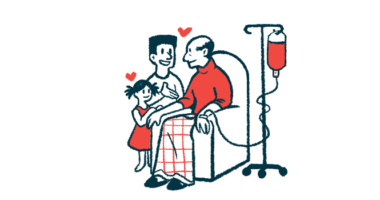New Trial Data Show ‘Promising’ Sustained Sutimlimab Effects

Sanofi’s investigational therapy sutimlimab safely and rapidly prevents red blood cell destruction (hemolysis), increases hemoglobin levels, and reduces fatigue in adults with primary cold agglutinin disease (CAD), according to full data from Part A of the Phase 3 CARDINAL study.
These therapeutic benefits were associated with a fast and pronounced suppression of the classical complement pathway, whose overactivation causes CAD, confirming sutimlimab’s mechanism of action and biological activity.
“These pivotal results underscore the clear and clinically meaningful treatment effect of sutimlimab on classical complement pathway activation, which triggers chronic hemolysis and anemia experienced by people living with cold agglutinin disease,” Alexander Röth, MD, of the West German Cancer Center, University Hospital Essen, in Germany, and the study’s lead investigator, said in a press release.
“These results are promising because of patients’ sustained response to sutimlimab over the duration of the study,” Röth said, adding that “sutimlimab has the potential to address a major unmet medical need for people with cold agglutinin disease.”
These findings were recently published in The New England Journal of Medicine in a study titled “Sutimlimab in Cold Agglutinin Disease”.
Developed by Sanofi’s subsidiary Bioverativ, sutimlimab works by selectively blocking the activity of C1 — a protein with a central role in the classical complement pathway, which is overly active in CAD, leading to hemolysis and anemia.
The complement system is a set of more than 30 blood proteins, mainly produced by the liver, that contribute to the body’s natural immune defenses. By suppressing only one of its pathways, the therapy ensures that the complement system is not completely inactive.
As such, sutimlimab is expected to prevent chronic hemolysis, increase the levels of hemoglobin — the protein responsible for transporting oxygen in red blood cells — and reduce or prevent the need for blood transfusions. That, in turn, will lessen patients’ disease burden and improve their quality of life.
Sutimlimab has received breakthrough therapy designation in the U.S., and orphan drug status in both the U.S. and Europe, for the treatment of hemolysis in CAD patients. Both designations are meant to speed up the therapy’s development and review.
It is now under review by the U.S. Food and Drug Administration as a potential therapy for hemolysis in adults with CAD. In November, the agency delayed its decision on sutimlimab due to the detection of issues in a third-party manufacturing facility that must be resolved before the therapy can earn approval. It is still unclear when a final decision will be made.
If approved, the medication will be the first hemolysis treatment for adults with CAD.
Meanwhile, the international, Phase 3 CARDINAL study (NCT03347396) is evaluating the safety and effectiveness of sutimlimab in 24 adults with primary CAD who had received at least one blood transfusion in the six months prior to enrollment.
In Part A, the participants — who had a median age of 72 — received weight-based doses of sutimlimab every week for the first two weeks, then every other week for another 24 weeks (about six months). The therapy was administered directly into the bloodstream.
CARDINAL Part A’s main goal was to assess whether the therapy could increase hemoglobin levels by at least 2 grams per deciliter (g/dL) from the study’s start, or normalize these levels to at least 12 g/dL, while preventing the need for additional blood transfusions.
Previously announced results from this part of the study showed that 54% of patients met this goal, with 63% achieving a hemoglobin normalization or an increase of at least 2 g/dL, and 71% continuing transfusion-free after week five.
Notably, patients’ mean hemoglobin level (at 8.6 g/dL at study entry) was maintained at values higher than 11 g/dL from week three onward.
The newly published data show that sutimlimab rapidly and efficiently suppressed hemolysis, as assessed by a reduction in the levels of bilirubin and lactate dehydrogenase (LDH), two markers of red blood cell destruction.
In particular, mean bilirubin levels normalized by week one, were maintained below the upper limit of the normal range until week 26, and coincided with the increase seen in hemoglobin levels. At the last study assessment, LDH levels had dropped by at least 1.5 times the upper limit of the normal range in 14 patients (58%).
In addition, clinically meaningful reductions in fatigue — as assessed through the Functional Assessment of Chronic Illness Therapy-Fatigue Score — were observed by week one, and maintained throughout the study, suggesting an overall improvement in patients’ quality of life.
All these therapeutic benefits, attained within the first weeks of treatment, coincided with the nearly complete suppression of the classic complement pathway from week one onward.
Sutimlimab was generally safe, with the frequency of adverse events (side effects) being generally consistent with those typically observed in this older, medically complex patient population, the team noted.
A total of 16 serious adverse events were reported in seven patients (29%), and one participant died of liver cancer. However, none of these events were deemed to be related to sutimlimab. Treatment-related adverse events were mild to moderate in severity.
Two participants withdrew from the trial prior to its completion, for reasons unrelated to the therapy.
These findings highlighted that “in patients with cold agglutinin disease who received sutimlimab, selective upstream inhibition of activity in the classic complement pathway rapidly halted hemolysis, increased hemoglobin levels, and reduced fatigue,” the researchers wrote.
This meant that the trial met both its main and secondary goals, suggesting that “targeting the classic complement pathway represents a new, effective therapeutic approach for the management of cold agglutinin disease,” the researchers wrote.
Moreover, previous results from a post-hoc analysis of CARDINAL Part A revealed that sutimlimab also reduced patient hospitalizations by more than threefold, and the number of blood transfusions by 75%.
All 22 participants who completed Part A chose to enter Part B, in which they will be receiving sutimlimab for up to two more years to assess the therapy’s long-term safety and durability of response.






